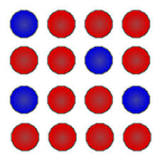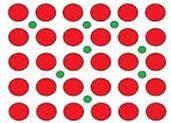
Interpretation:
The difference between metal alloy sterling silver and carbon steel in terms of alloys involved.
Concept introduction:
Alloys are a combination of different metal elements to give increased strength and hardness. Moreover, such alloys have enhanced property wherein the material has resistance to corrosion, good mechanical properties. Example are Bronze, Brass and steel. There are two types of alloys − substitutional alloys and interstitial alloys.
Answer to Problem 98A
Alloying sterling silver is a substitutional alloy while carbon steel is interstitial alloy.
Explanation of Solution
Alloys are obtained by combining one or two elements to the metal. It is a solution of metallic-solid that is composed of two or more elements. Here the size of metal ions and the added elements have almost the same size.
Sterling silver is a combination of copper and silver with higher proportion of silver. It is a heterogenous mixture which has around 93% silver and 7 % other metals. Here, sterling silver is having shared electrons and there exists covalent bonds.

The sizes of the copper ions are almost similar to silver ion and hence substituted.
Carbon steel is a combination of carbon and iron. The carbon atoms are smaller in diameter that positive ion. It will fit into the interstices of the metal lattice. Here, carbon steel is considered as interstitial alloy as the carbon atoms will fit in the interstices of the metal compound.

Alloying sterling silver is a substitutional alloy while carbon steel is interstitial alloy.
Chapter 7 Solutions
Chemistry: Matter and Change
Additional Science Textbook Solutions
Organic Chemistry (8th Edition)
Essential Organic Chemistry (3rd Edition)
General Chemistry: Principles and Modern Applications (11th Edition)
Chemistry: A Molecular Approach
 ChemistryChemistryISBN:9781305957404Author:Steven S. Zumdahl, Susan A. Zumdahl, Donald J. DeCostePublisher:Cengage Learning
ChemistryChemistryISBN:9781305957404Author:Steven S. Zumdahl, Susan A. Zumdahl, Donald J. DeCostePublisher:Cengage Learning ChemistryChemistryISBN:9781259911156Author:Raymond Chang Dr., Jason Overby ProfessorPublisher:McGraw-Hill Education
ChemistryChemistryISBN:9781259911156Author:Raymond Chang Dr., Jason Overby ProfessorPublisher:McGraw-Hill Education Principles of Instrumental AnalysisChemistryISBN:9781305577213Author:Douglas A. Skoog, F. James Holler, Stanley R. CrouchPublisher:Cengage Learning
Principles of Instrumental AnalysisChemistryISBN:9781305577213Author:Douglas A. Skoog, F. James Holler, Stanley R. CrouchPublisher:Cengage Learning Organic ChemistryChemistryISBN:9780078021558Author:Janice Gorzynski Smith Dr.Publisher:McGraw-Hill Education
Organic ChemistryChemistryISBN:9780078021558Author:Janice Gorzynski Smith Dr.Publisher:McGraw-Hill Education Chemistry: Principles and ReactionsChemistryISBN:9781305079373Author:William L. Masterton, Cecile N. HurleyPublisher:Cengage Learning
Chemistry: Principles and ReactionsChemistryISBN:9781305079373Author:William L. Masterton, Cecile N. HurleyPublisher:Cengage Learning Elementary Principles of Chemical Processes, Bind...ChemistryISBN:9781118431221Author:Richard M. Felder, Ronald W. Rousseau, Lisa G. BullardPublisher:WILEY
Elementary Principles of Chemical Processes, Bind...ChemistryISBN:9781118431221Author:Richard M. Felder, Ronald W. Rousseau, Lisa G. BullardPublisher:WILEY





